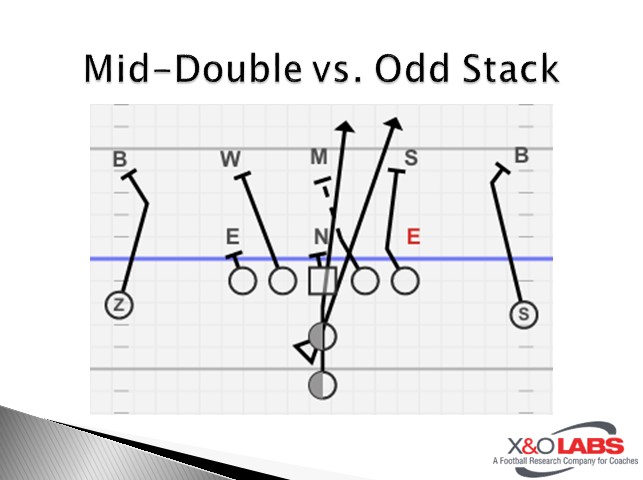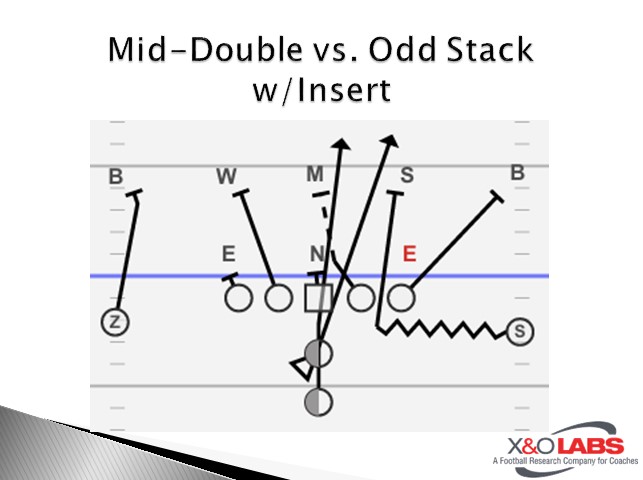By Scott Hansen
QB Coach/Passing Game Coordinator
Hinsdale South High School (IL)
Twitter: @CoachHansen05
As someone who was raised on the Split Back Veer (SBV) from under center, I am what you may call an “option purist.” I ran SBV as a quarterback for four years and coached it for another five. Combine that with the time that I’ve spent studying and coaching the Flexbone Triple, and you’ve got a coach who’s pretty set in his beliefs. With that said, I also understand that any coach worth his salt knows that he has to evolve as the game evolves.
When I was hired to my current position, I was expected to be open minded. Our offense combined the traditional Flexbone Triple with Spread concepts. As part of this scheme, we would put our quarterback was in the short pistol, 2 ½ yards from the center. The reason for this being that having the QB closer to the center than a traditional Pistol formation allows us to align our fullback so that his hand is on the ground at 5 yards depth. I was initially curious to see how the timing of the snap, the mesh, and the point of attack all worked in synchronicity.
While I was skeptical at first, it was easier to buy in after seeing the big picture. Here is a list of the ways that we feel we gain an advantage using the short pistol:
- Aids the QB in gaining depth for reading all option plays
- Protects the mesh from upfield penetration or a stalemate at the LOS
- Causes read keys to take a definitive angle
- Puts the QB at the proper depth for the quick passing game
- Disguises the intent of slot motion (slots align even with the QB)


The Quarterback
For the quarterback, the teaching progression starts with catching the snap. In the short pistol, the snap resembles that of a shotgun snap with some minor differences. We teach our center a two-handed “flip” to get the ball back to the quarterback. He turns the laces to match the handedness of the QB and flips the ball back aiming for two end-over-end revolutions. The QB begins his footwork while catching the snap. His eyes go through the ball to the dive read.
I teach simple cues to help our QBs learn muscle memory as quickly as possible:
- “Flip the hips.” The backside foot clears the midline while the playside foot moves to 6 o’clock. Feet should move simultaneously, and the majority of body weight should be on the back foot. The most common mistake is for the QB to jump off the ground. Rather, his feet should be gliding to the proper position.
- “Reach and teach.” We subscribe to the “Ride and Decide” method in terms of the mesh. The QB will “reach” the ball back to his playside foot. Ideally, the ball is placed directly on the midline. Once reaching the ball, the QB will “teach” the dive read. Whatever the dive read does is wrong.
- “Give and take.” If the QB gives the ball, then he prepares to take contact from the dive read. We teach our QBs to absorb, not accept contact. He will give with the hit. This technique is the same whether we are running Mid-Double or Mid-Triple. If we can carry out the fake to the pitch phase, then it’s a bonus.
- “Pull and replace.” If the QB pulls the ball, then he replaces the dive read by pushing off of his playside foot into the LOS. In Mid-Double, there is no pitch read, so the QB is taught to get vertical now.
- “Pull. Pitch.” In Mid-Triple, if the QB pulls the ball, he is taught to step to the pitch and get it out there. Against a 4-man front, the EMLOS is rarely a pitch player. The same applies to a 3-4/5-2. Against a 3-3 Stack, however, the QB is drilled on reading the stack. Normally, the stack LB is taught to fit for QB, which means he’ll have to be special to run down our pitch back. Regardless of how you teach it, it is important that the QB understands that Mid-Triple is either a give or a pitch.









